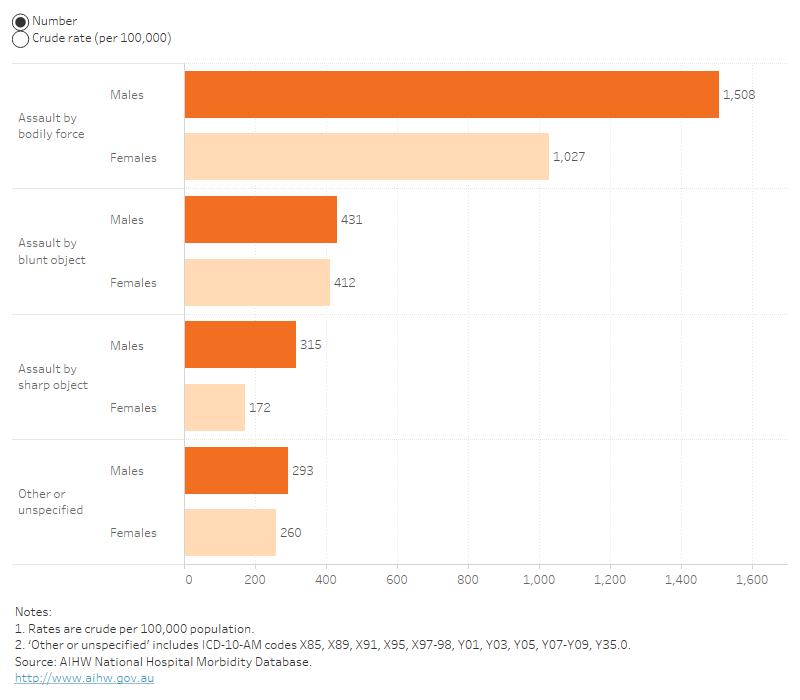Assault
Box 9: How alcohol-related assault hospitalisations are counted
This report includes data on people hospitalised due to assault where there is evidence in the hospital record that the person hospitalised had consumed alcohol. Therefore, it does not include cases where the assault perpetrator had consumed alcohol and the person hospitalised had not.
There is limited information in the data source about the relationship of the assault perpetrator to the person who is hospitalised (for example, if they are a spouse or partner, family member, or an unknown person) when that detail is specified in the hospital record. It is not possible to know from the data if the perpetrator had consumed alcohol.
One in 5 (4,400) of the 22,100 hospitalised assault injuries in Australia in 2019–20 was for cases where the person hospitalised had consumed alcohol (Table 6). Males (21 cases per 100,000) had a higher age-standardised rate than females (15 cases per 100,000) (Figure 3).
Over half of alcohol-related assault cases (57%; 2,500 cases) were Assaults by bodily force for example being pushed or punched (not including sexual assault). Other causes of assault hospitalisations included Assault by blunt object (19%; 840 cases) and Assault by sharp object (11%; 485 cases) (Figure 7).
Figure 7: Selected types of assault alcohol-related hospitalisations by sex, 2019–20
Bar graph showing that assaults by bodily force were the largest assault type for both sexes. For all types of assault, the numbers and rates were higher for males than females.

Assault perpetrators
Among the 4,400 alcohol-related hospitalisations for assault in this report, a perpetrator relationship was specified in 64% (2,800) of cases. Of those 2,800 cases, 61% (1,700) were cases of assault where the perpetrator was a spouse or partner or family member. These cases are broadly defined as family and domestic violence (AIHW 2022). See Family, domestic and sexual violence for more detailed AIHW data. Note, the sex of the perpetrator is not recorded in the source data.
One in 5 (20%) of hospitalisations due to assault in Australia in 2019–20 involved consumption of alcohol by the person who was hospitalised due to an assault. These data do not include whether the perpetrator also consumed alcohol.
| Alcohol-related assault hospitalisations | All assault hospitalisations | % with alcohol involvement | |
|---|---|---|---|
| Family member | 1,709 | 7,639 | 22 |
| Spouse or domestic partner | 1,043 | 4,822 | 22 |
| Parent | 21 | 498 | 4.2 |
| Other family member | 645 | 2,316 | 28 |
| Acquantance or friend | 417 | 2,246 | 19 |
| Person(s) unknown | 502 | 3,393 | 15 |
| Other specified person/authorities | 182 | 1,488 | 12 |
| Unspecified person | 1,584 | 7,353 | 22 |
| Total | 4,418 | 22,116 | 20 |
Note: ‘Total’ includes records where the assault perpetrator was missing. Therefore, ‘Total’ may be greater than the sum of each perpetrator group.
Source: AIHW National Hospital Morbidity Database.
For more detailed data, see Data tables A14–17.
AIHW (2022) Family, domestic and sexual violence, AIHW, Australian Government, accessed 29 July 2022.


